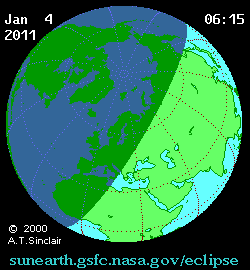Wednesday's total eclipse of the Moon may be the most striking for years but observers in Britain must be content with a view of only the closing act of the drama. The Moon stands over the southern Indian Ocean as it passes through the central dark umbra of the Earth's shadow, plunging deeper into the shadow than during any eclipse since 2000. This may well result in an unusually dark eclipse, with the Moon's disc turning a deep reddish-brown as all direct sunlight is blocked.
In fact, the umbra is never black. A little light must reach the Moon from the parts of the Sun's outer atmosphere, the corona, that are not hidden by the Earth. But more sunlight is refracted and scattered around the edge of the Earth by our planet's atmosphere. Just as sunsets and sunrises appear orange or red, so this light is predominantly red.
The umbra is not illuminated evenly, though, since less of this indirect light penetrates to its core and the amount reaching different zones of the umbra is affected by varying atmospheric conditions. In particular, dust thrown up by major volcanic eruptions can render the atmosphere less transparent and the eclipsed Moon so dark that it practically disappears.
Our image shows the previous total lunar eclipse as viewed from Florida last December. On that occasion, the Moon traversed the northern part of the umbra and its southern regions, which just missed the shadow's core, are relatively dark. This week, the Moon passes about a half Moon's-breadth farther southwards with respect to the shadow, so it will be interesting to discover just how dark and colourful it appears.
Wednesday's eclipse begins when the Moon's eastern limb begins to enter the penumbra of the Earth's shadow at 18:25 BST. While within the penumbra, some direct sunlight falls on the Moon but little darkening of the disc will be noticed until a few minutes before the Moon begins to enter the umbra at 19:23. Totality, with the Moon entirely within the umbra, lasts from 20:22 until 22:03 with mid eclipse at 21:13. The Moon's W limb has withdrawn from the umbra by 23:02 and finally exits the penumbra at 00:01.
For Britain, other than the far NW, the Moon rises in the SE during the latter half of totality. Observers in SE England may just glimpse the end of totality, but most of us may see nothing until it begins to emerge from the umbra. From London and Manchester, for example, the Moon stands less than 5° and 3° high respectively at 22:03 BST, with the Sun only a little way below the NW horizon and the sky brightly twilit. The Moon should be more obvious another 5° higher in a darker sky by 23:02
















